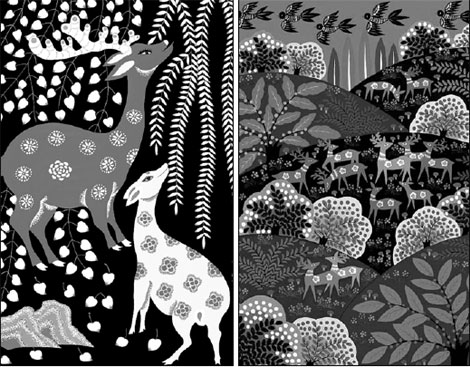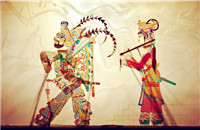An imperial tonic now available for everyone
|
Paintings depict deer and rural life in Dongfeng county. Wang Hailing and Liu Zhenqi / for China Daily |
Dongfeng county, near the Changbai Mountains, has a long history of sika deer - 200 years in fact.
It can be traced back to the Qing Dynasty (1644-1912), when the area around Dongfeng was an imperial hunting reserve, known as the Shengjing Hunting Field. Commoners were not allowed to live or work in it.
The emperor sent soldiers to protect the area, and many of its rare and valuable plant and animal species were sent to the royal family as tribute. According to historical records, the sika deer was the main form of tribute to the emperor every year.
In late Qing, the emperor hunted in the area less and controls got looser and many local people started cultivating and hunting on the imperial land.
One autumn, a member of the aristocracy went hunting in the now-neglected land and was overwhelmed by its beauty, scenery, and plentitude. Because of her discovery, the Shengjing Hunting Field sprung to life again for the royal family.
She returned to the palace and told her sister, the Empress Dowager Cixi and, after looking into the matter, Cixi decided to allow 48 local families to hunt within a fixed area under the condition that they contribute 20 sika deer to the government every year.
The hunters used traps and dogs to hunt the sika deer, but gradually found it difficult to satisfy the government's demands.
So, one hunter, Zhao Yunji, was chosen in 1895 to make a proposal on captive breeding to the emperor. The emperor approved the suggestion and even offered the man an official position, putting him in charge of sika deer breeding.
The following year, an imperial deer park was established, and Zhao was appointed to run it. The government ordered that all sika deer hunted in Jilin and Heilongjiang provinces be sent to the deer park. At the time, it had only 60 of the animals.
Then, Zhao Yunji's son, Zhao Zhenshan, succeeded him and the successful breeding of sika deer continued. The deer park grew bigger until, in 1911, it had more than 500 sika deer.
After the monarchy was overthrown, the dear park became the Zhaos' private property and they no longer pay a tribute to the government, so the number of deer grew rapidly.
Zhao Zhenshan asked pharmacologists to look for ways to use the deer antler and fetuses for medicine. They experimented with combining pilose antler, ginseng and other traditional Chinese medicine materials.
Zhao then opened his own pharmacy to sell medicines and tonics made from sika deer antlers, blood and fetuses.
At the opening, the ceremony was something to behold. Even the local warlord Chang Tso-lin and his son, Chang Hsueh-liang, came to congratulate the owner and were impressed by the deer park's magnificence and the pharmacy's ornamentation.
(China Daily 08/26/2011 page14)















